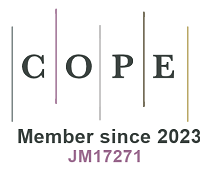REFERENCES
1. Abbasi, G.; Buser, A. M.; Soehl, A.; Murray, M. W.; Diamond, M. L. Stocks and flows of PBDEs in products from use to waste in the U.S. and Canada from 1970 to 2020. Environ. Sci. Technol. 2015, 49, 1521-8.
2. Arkoosh, M. R.; Boylen, D.; Dietrich, J.; et al. Disease susceptibility of salmon exposed to polybrominated diphenyl ethers (PBDEs). Aquat. Toxicol. 2010, 98, 51-9.
3. Arkoosh, M. R.; Van Gaest, A. L.; Strickland, S. A.; et al. Dietary exposure to a binary mixture of polybrominated diphenyl ethers alters innate immunity and disease susceptibility in juvenile Chinook salmon (Oncorhynchus tshawytscha). Ecotoxicol. Environ. Saf. 2018, 163, 96-103.
4. Akortia, E.; Okonkwo, J. O.; Lupankwa, M.; et al. A review of sources, levels, and toxicity of polybrominated diphenyl ethers (PBDEs) and their transformation and transport in various environmental compartments. Environ. Rev. 2016, 24, 253-73.
5. Arkoosh, M. R.; Van Gaest, A. L.; Strickland, S. A.; Hutchinson, G. P.; Krupkin, A. B.; Dietrich, J. P. Alteration of thyroid hormone concentrations in juvenile Chinook salmon (Oncorhynchus tshawytscha) exposed to polybrominated diphenyl ethers, BDE-47 and BDE-99. Chemosphere 2017, 171, 1-8.
6. Kim, T.; Kwon, Y.; Kwon, S. Bromination effect of polybrominated diphenyl ethers on the graphyne surface on enhanced adsorption characteristics using density functional theory study. AIP. Adv. 2020, 10, 075117.
7. Carey, A. J.; Wese, J. E.; Fisk, R. J.; Langness, M.; Ylitalo, G.; O’Neill, S. Location and source of PBDE exposure in juvenile Chinook salmon along their out-migrant pathway through the Snohomish River, WA. 2019. https://wdfw.wa.gov/publications/02241. (accessed on 2025-03-17).
8. Kim, M.; Han, J. Treatment techniques for removal of polybrominated diphenyl ethers (PBDEs) from real wastewater: Limitations, challenges, and future research directions. J. Water. Process. Eng. 2024, 63, 105463.
9. James, C. A.; Sofield, R.; Faber, M.; et al. The screening and prioritization of contaminants of emerging concern in the marine environment based on multiple biological response measures. Sci. Total. Environ. 2023, 886, 163712.
10. Xu, G.; Zhao, X.; Zhao, S.; et al. Insights into the occurrence, fate, and impacts of halogenated flame retardants in municipal wastewater treatment plants. Environ. Sci. Technol. 2021, 55, 4205-26.
11. Sun, Y.; Francois, R.; Pawlowicz, R.; Maldonado, M. T.; Stevens, S. W.; Soon, M. Distribution, sources and dispersion of polybrominated diphenyl ethers in the water column of the Strait of Georgia, British Columbia, Canada. Sci. Total. Environ. 2023, 873, 162174.
12. Zhang, Y.; Wang, W.; Song, J.; et al. Environmental characteristics of polybrominated diphenyl ethers in marine system, with emphasis on marine organisms and sediments. Biomed. Res. Int. 2016, 2016, 1317232.
13. Lee, H. K.; Kim, S. J.; Jeong, Y.; et al. Polybrominated diphenyl ethers in thirteen shark species from offshore and coastal waters of Korea. Mar. Pollut. Bull. 2015, 95, 374-9.
14. Mongillo, T. M.; Holmes, E. E.; Noren, D. P.; et al. Predicted polybrominated diphenyl ether (PBDE) and polychlorinated biphenyl (PCB) accumulation in southern resident killer whales. Mar. Ecol. Prog. Ser. 2012, 453, 263-77.
15. Morales, P.; Roscales, J. L.; Muñoz-Arnanz, J.; Barbosa, A.; Jiménez, B. Evaluation of PCDD/Fs, PCBs and PBDEs in two penguin species from Antarctica. Chemosphere 2022, 286, 131871.
16. Kim, U. J.; Jo, H.; Lee, I. S.; Joo, G. J.; Oh, J. E. Investigation of bioaccumulation and biotransformation of polybrominated diphenyl ethers, hydroxylated and methoxylated derivatives in varying trophic level freshwater fishes. Chemosphere 2015, 137, 108-14.
17. West, J. E.; O’Neill, S. M.; Ylitalo, G. M. Time trends of persistent organic pollutants in benthic and pelagic indicator fishes from Puget Sound, Washington, USA. Arch. Environ. Contam. Toxicol. 2017, 73, 207-29.
18. Rayne, S.; Ikonomou, M. G.; Ross, P. S.; Ellis, G. M.; Barrett-Lennard, L. G. PBDEs, PBBs, and PCNs in three communities of free-ranging killer whales (Orcinus orca) from the northeastern Pacific Ocean. Environ. Sci. Technol. 2004, 38, 4293-9.
19. Ikonomou, M. G.; Fernandez, M. P.; Hickman, Z. L. Spatio-temporal and species-specific variation in PBDE levels/patterns in British Columbia’s coastal waters. Environ. Pollut. 2006, 140, 355-63.
20. Td, MacRae JD. Polybrominated diphenyl ethers in fish and wastewater samples from an area of the Penobscot River in central Maine. Chemosphere 2006, 62, 1153-60.
21. O’Neill, S. M.; Carey, A. J.; Harding, L. B.; West, J. E.; Ylitalo, G. M.; Chamberlin, J. W. Chemical tracers guide identification of the location and source of persistent organic pollutants in juvenile Chinook salmon (Oncorhynchus tshawytscha), migrating seaward through an estuary with multiple contaminant inputs. Sci. Total. Environ. 2020, 712, 135516.
22. Wong, S. Chemicals of emerging concern in pretreated industrial wastewater in northwestern Washington State: screening study results, 2021. https://apps.ecology.wa.gov/publications/documents/2203013.pdf. (accessed on 2025-03-17).
23. Xu, H.; Cai, Q.; An, Q.; et al. Aerobic degradation characteristics of decabromodiphenyl ether through rhodococcus ruber TAW-CT127 and its preliminary genome analysis. Microorganisms 2022, 10, 1441.
24. Paliya, S.; Mandpe, A.; Bhisikar, D.; Kumar, M. S.; Kumar, S. Polybrominated diphenyl ethers (PBDEs) in Indian wastewater treatment plant: occurrence, mass flow and removal. Chemosphere 2022, 303, 135055.
25. Shen, J.; Smyth, S. A.; Droste, R.; Delâge, D. Variability of release rate of flame retardants in wastewater treatment plants. Environ. Sci. Pollut. Res. Int. 2018, 25, 34740-52.
26. Chang, R.; Jien, S.; Weng, C.; Lee, T.; Liao, C. Fast Removal of polybrominated diphenyl ethers from aqueous solutions by using low-cost adsorbents. Sustainability 2017, 9, 102.
27. Duan, F. A.; Wang, J.; Ismail, S.; Sung, S.; Cui, Z.; Ni, S. Q. Hydroxypropyl-β-cyclodextrin improves the removal of polycyclic aromatic hydrocarbons by aerobic granular sludge. Environ. Technol. 2022, 43, 3262-8.
28. Mohamed, B. A.; Hamid, H.; Montoya-Bautista, C. V.; Li, L. Y. Circular economy in wastewater treatment plants: treatment of contaminants of emerging concerns (CECs) in effluent using sludge-based activated carbon. J. Clean. Prod. 2023, 389, 136095.
29. Hu, D.; Wu, J.; Fan, L.; Li, S.; Jia, R. Aerobic degradation characteristics and mechanism of decabromodiphenyl ether (BDE-209) using complex bacteria communities. Int. J. Environ. Res. Public. Health. 2022, 19, 17012.
30. Gu, C.; Wang, L.; Jin, Z.; et al. Congener-specificity, dioxygenation dependency and association with enzyme binding for biodegradation of polybrominated diphenyl ethers by typical aerobic bacteria: Experimental and theoretical studies. Chemosphere 2023, 314, 137697.
31. Ni, S. Q.; Cui, Q.; Zheng, Z. Interaction of polybrominated diphenyl ethers and aerobic granular sludge: biosorption and microbial degradation. Biomed. Res. Int. 2014, 2014, 274620.
32. He, J.; Robrock, K. R.; Alvarez-Cohen, L. Microbial reductive debromination of polybrominated diphenyl ethers (PBDEs). Environ. Sci. Technol. 2006, 40, 4429-34.
33. Zhao, S.; Fan, S.; He, Y.; Zhang, Y. Microbial debromination of polybrominated diphenyl ethers by dehalococcoides-containing enrichment culture. Front. Microbiol. 2021, 12, 806795.
34. Zhao, S.; Rogers, M. J.; Cao, L.; Ding, C.; He, J. Identification of reductive dehalogenases that mediate complete debromination of penta- and tetrabrominated diphenyl ethers in Dehalococcoides spp. Appl. Environ. Microbiol. 2021, 87, e0060221.
35. Xu, G.; Zhao, S.; He, J. Underexplored organohalide-respiring bacteria in sewage sludge debrominating polybrominated diphenyl ethers. Environ. Sci. Technol.2024.
36. Yu, Y.; Yin, H.; Huang, W.; Peng, H.; Lu, G.; Dang, Z. Cellular changes of microbial consortium GY1 during decabromodiphenyl ether (BDE-209) biodegradation and identification of strains responsible for BDE-209 degradation in GY1. Chemosphere 2020, 249, 126205.
37. Zhou, Q.; Ge, C.; Ahmad, H. A.; et al. Production of more toxic hexa-brominated diphenyl ether from rapid biotransformation of decabromodiphenyl ether in anaerobic granular sludge. Int. Biodeterior. Biodegrad. 2018, 134, 7-15.
38. Wang, S.; Bai, N.; Wang, B.; et al. Characterization of the molecular degradation mechanism of diphenyl ethers by Cupriavidus sp. WS. Environ. Sci. Pollut. Res. Int. 2015, 22, 16914-26.
39. Robrock, K. R.; Korytár, P.; Alvarez-Cohen, L. Pathways for the anaerobic microbial debromination of polybrominated diphenyl ethers. Environ. Sci. Technol. 2008, 42, 2845-52.
40. Kent, J.; Tay, J. H. Treatment of 17α-ethinylestradiol, 4-nonylphenol, and carbamazepine in wastewater using an aerobic granular sludge sequencing batch reactor. Sci. Total. Environ. 2019, 652, 1270-8.
41. Kryst, K.; Karamanev, D. G. Aerobic phenol biodegradation in an inverse fluidized-bed biofilm reactor. Ind. Eng. Chem. Res. 2001, 40, 5436-9.
42. Lendenmann, U.; Spain, J. C.; Smets, B. F. Simultaneous biodegradation of 2,4-dinitrotoluene and 2,6-dinitrotoluene in an aerobic fluidized-bed biofilm reactor. Environ. Sci. Technol. 1998, 32, 82-7.
43. Swain, A. K.; Sahoo, A.; Jena, H. M.; Patra, H. Industrial wastewater treatment by Aerobic Inverse Fluidized Bed Biofilm Reactors (AIFBBRs): a review. J. Water. Process. Eng. 2018, 23, 61-74.
44. Cui, L.; Yan, J.; Yang, Y.; et al. Influence of biochar on microbial activities of heavy metals contaminated paddy fields. BioRes 2013, 8, 5536-48.
45. Chen, Y.; Liu, Y.; Li, Y.; et al. Influence of biochar on heavy metals and microbial community during composting of river sediment with agricultural wastes. Bioresour. Technol. 2017, 243, 347-55.
46. Pommier, T.; Merroune, A.; Bettarel, Y.; et al. Off-site impacts of agricultural composting: role of terrestrially derived organic matter in structuring aquatic microbial communities and their metabolic potential. FEMS. Microbiol. Ecol. 2014, 90, 622-32.
47. Kambo, H. S.; Dutta, A. A comparative review of biochar and hydrochar in terms of production, physico-chemical properties and applications. Renew. Sustain. Energy. Rev. 2015, 45, 359-78.
48. Xiang, W.; Zhang, X.; Chen, J.; et al. Biochar technology in wastewater treatment: a critical review. Chemosphere 2020, 252, 126539.
49. Colantoni, A.; Evic, N.; Lord, R.; et al. Characterization of biochars produced from pyrolysis of pelletized agricultural residues. Renew. Sustain. Energy. Rev. 2016, 64, 187-94.
50. Xiong, X.; Yu, I. K.; Tsang, D. C.; et al. Value-added chemicals from food supply chain wastes: state-of-the-art review and future prospects. Chem. Eng. J. 2019, 375, 121983.
51. Ming, J.; Wang, Q.; Yoza, B. A.; et al. Bioreactor performance using biochar and its effect on aerobic granulation. Bioresour. Technol. 2020, 300, 122620.
52. El Shahawy, A.; Mohamed, A.; El-Shatoury, S.; et al. Using phragmites australis biochar bio-augmented with actinomycetes for enhancing UASB reactor performance: a field study. J. Water. Process. Eng. 2024, 68, 106461.
53. Chakraborty, I.; Sathe, S. M.; Dubey, B. K.; Ghangrekar, M. M. Waste-derived biochar: applications and future perspective in microbial fuel cells. Bioresour. Technol. 2020, 312, 123587.
54. Lin, S.; Rong, K.; Lamichhane, K. M.; Babcock, R. W.; Kirs, M.; Cooney, M. J. Anaerobic-aerobic biofilm-based digestion of chemical contaminants of emerging concern (CEC) and pathogen indicator organisms in synthetic wastewater. Bioresour. Technol. 2020, 299, 122554.
55. Chan, Y. J.; Chong, M. F.; Law, C. L.; Hassell, D. A review on anaerobic–aerobic treatment of industrial and municipal wastewater. Chem. Eng. J. 2009, 155, 1-18.
56. Qiu, M.; Chen, X.; Deng, D.; et al. Effects of electron donors on anaerobic microbial debromination of polybrominated diphenyl ethers (PBDEs). Biodegradation 2012, 23, 351-61.
57. Lust, M. J.; Ziels, R. M.; Strand, S. E.; Gough, H. L.; Stensel, H. D. Biodegradation kinetics of 17α-ethinylestradiol in activated sludge treatment processes. Environ. Eng. Sci. 2015, 32, 637-46.
58. Zhou, N. A.; Lutovsky, A. C.; Andaker, G. L.; Ferguson, J. F.; Gough, H. L. Kinetics modeling predicts bioaugmentation with Sphingomonad cultures as a viable technology for enhanced pharmaceutical and personal care products removal during wastewater treatment. Bioresour. Technol. 2014, 166, 158-67.
59. Zhou, N. A.; Lutovsky, A. C.; Andaker, G. L.; Gough, H. L.; Ferguson, J. F. Cultivation and characterization of bacterial isolates capable of degrading pharmaceutical and personal care products for improved removal in activated sludge wastewater treatment. Biodegradation 2013, 24, 813-27.
60. Ziels, R. M.; Lust, M. J.; Gough, H. L.; Strand, S. E.; Stensel, H. D. Influence of bioselector processes on 17α-ethinylestradiol biodegradation in activated sludge wastewater treatment systems. Environ. Sci. Technol. 2014, 48, 6160-7.
61. Shao, Y.; Ye, W.; Sun, C.; Liu, C.; Wang, Q. Visible-light-induced degradation of polybrominated diphenyl ethers with AgI–TiO2. RSC. Adv. 2017, 7, 39089-95.
62. Wang, R.; Tang, T.; Wei, Y.; et al. Photocatalytic debromination of polybrominated diphenyl ethers (PBDEs) on metal doped TiO2 nanocomposites: mechanisms and pathways. Environ. Int. 2019, 127, 5-12.







